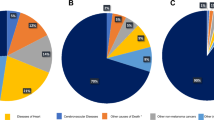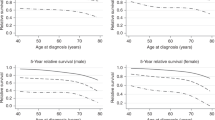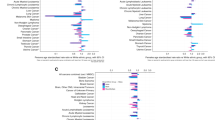Abstract
Background
Protracted times to diagnosis of cancer can lead to increased patient anxiety, and in some cases, disease progression and worse outcomes. This study assessed the time to diagnosis for melanoma, and its variability, according to patient-, disease-, and system-level factors.
Methods
This is a descriptive, cross-sectional study in Ontario, Canada from 2007–2019. We used administrative health data to measure the diagnostic interval (DI)–and its two subintervals–the primary care subinterval (PCI) and specialist care subinterval (SCI). Multivariable quantile regression was used.
Results
There were 33,371 melanoma patients. The median DI was 36 days (interquartile range [IQR]: 8–85 days), median PCI 22 days (IQR: 6–54 days), and median SCI 6 days (IQR: 1–42 days). Increasing comorbidity was associated with increasing DI. Residents in the most deprived neighbourhoods and those in rural areas experienced shorter DIs and PCIs, but no differences in SCI. There was substantial variation in the DI and SCI across health regions, but limited differences in the PCI. Finally, patients with a history of non-melanoma skin cancer, and those previously established with a dermatologist experienced significantly longer DI, PCI, and SCI.
Discussion
This study found variability in the melanoma DI, notably by system-level factors.
This is a preview of subscription content, access via your institution
Access options
Subscribe to this journal
Receive 24 print issues and online access
$259.00 per year
only $10.79 per issue
Buy this article
- Purchase on Springer Link
- Instant access to full article PDF
Prices may be subject to local taxes which are calculated during checkout

Similar content being viewed by others
Data availability
The dataset from this study is held securely in coded form at ICES. While legal data sharing agreements between ICES and data providers (e.g., healthcare organisations and government) prohibit ICES from making the dataset publicly available, access may be granted to those who meet pre-specified criteria for confidential access, available at www.ices.on.ca/DAS (email: das@ices.on.ca).
References
Sung H, Ferlay J, Siegel RL, Laversanne M, Soerjomataram I, Jemal A, et al. Global cancer statistics 2020: GLOBOCAN estimates of incidence and mortality worldwide for 36 cancers in 185 countries. CA Cancer J Clin. 2021;71:209–49.
Canadian Cancer Statistics Advisory Committee. Canadian cancer statistics 2019. Toronto, ON: Canadian Cancer Society; 2019.
O’Sullivan DE, Brenner DR, Villeneuve PJ, Walter SD, Demers PA, Friedenreich CM, et al. Estimates of the current and future burden of melanoma attributable to ultraviolet radiation in Canada. Prev Med. 2019;122:81–90.
Welch HG, Mazer BL, Adamson AS. The rapid rise in cutaneous melanoma diagnoses. N Engl J Med. 2021;384:72–9.
Lipsker D, Engel F, Cribier B, Velten M, Hedelin G. Trends in melanoma epidemiology suggest three different types of melanoma. Br J Dermatol. 2007;157:338–43.
Sacchetto L, Zanetti R, Comber H, Bouchardy C, Brewster DH, Broganelli P, et al. Trends in incidence of thick, thin and in situ melanoma in Europe. Eur J Cancer. 2018;92:108–18.
Watson M, Geller AC, Tucker MA, Guy GP Jr., Weinstock MA. Melanoma burden and recent trends among non-Hispanic whites aged 15-49years, United States. Prev Med. 2016;91:294–8.
Hynes MC, Nguyen P, Groome PA, Asai Y, Mavor ME, Baetz TD, et al. A population-based validation study of the 8th edition UICC/AJCC TNM staging system for cutaneous melanoma. BMC Cancer. 2022;22:720.
Weller D, Vedsted P, Rubin G, Walter FM, Emery J, Scott S, et al. The Aarhus statement: improving design and reporting of studies on early cancer diagnosis. Br J Cancer. 2012;106:1262–7.
Webber C, Flemming JA, Birtwhistle R, Rosenberg M, Groome PA. Colonoscopy resource availability and its association with the colorectal cancer diagnostic interval: a population-based cross-sectional study. Eur J Cancer Care. 2020;29:e13187.
Siminoff LA, Rogers HL, Thomson MD, Dumenci L, Harris-Haywood S. Doctor, what’s wrong with me? Factors that delay the diagnosis of colorectal cancer. Patient Educ Couns. 2011;84:352–8.
Mounce LTA, Price S, Valderas JM, Hamilton W. Comorbid conditions delay diagnosis of colorectal cancer: a cohort study using electronic primary care records. Br J Cancer. 2017;116:1536–43.
Gwyn K, Bondy ML, Cohen DS, Lund MJ, Liff JM, Flagg EW, et al. Racial differences in diagnosis, treatment, and clinical delays in a population-based study of patients with newly diagnosed breast carcinoma. Cancer. 2004;100:1595–604.
Montella M, Crispo A, D’Aiuto G, De Marco MR, de Bellis G, Fabbrocini G, et al. Determinant factors for diagnostic delay in operable breast cancer patients. Eur J Cancer Prev. 2001;10:53–9.
Schmid-Wendtner MH, Baumert J, Stange J, Volkenandt M. Delay in the diagnosis of cutaneous melanoma: an analysis of 233 patients. Melanoma Res. 2002;12:389–94.
Richard MA, Grob JJ, Avril MF, Delaunay M, Thirion X, Wolkenstein P, et al. Melanoma and tumour thickness: challenges of early diagnosis. Arch Dermatol. 1999;135:269–74.
Montella M, Crispo A, Grimaldi M, De Marco MR, Ascierto PA, Parasole R, et al. An assessment of factors related to tumor thickness and delay in diagnosis of melanoma in southern Italy. Prev Med. 2002;35:271–7.
Baade P, English D, Youl P, McPherson M, Elwood M, Aitken J. The relationship between melanoma thickness and time to diagnosis in a large population based study. Arch Dermatol. 2006;142:1422–7.
Brochez L, Verhaeghe E, Bleyen L, Naeyaert JM. Time delays and related factors in the diagnosis of cutaneous melanoma. Eur J Cancer. 2001;37:843–8.
Cassileth BR, Clark WH, Heiberger RM, March V, Tenaglia A. Relationship between patients’ early recognition of melanoma and depth of invasion. Cancer. 1982;49:198–200.
Tyler I, Rivers JK, Shoveller JA, Blum A. Melanoma detection in British Columbia, Canada. J Am Acad Dermatol. 2005;52:48–54.
von Elm E, Altman DG, Egger M, Pocock SJ, Gotzsche PC, Vandenbroucke JP, et al. The Strengthening the Reporting of Observational Studies in Epidemiology (STROBE) Statement: guidelines for reporting observational studies. Int J Surg. 2014;12:1495–9.
Benchimol EI, Smeeth L, Guttmann A, Harron K, Moher D, Petersen I, et al. The REporting of studies Conducted using Observational Routinely-collected health Data (RECORD) statement. PLoS Med. 2015;12:e1001885.
Robles SC, Marrett LD, Clarke EA, Risch HA. An application of capture-recapture methods to the estimation of completeness of cancer registration. J Clin Epidemiol. 1988;41:495–501.
Tran JM, Schwartz R, Fung K, Rochon P, Chan AW. Comprehensive capture of cutaneous melanoma by the Ontario Cancer Registry: validation study using community pathology reports. Cancer Causes Control. 2016;27:137–42.
Mavor ME, Richardson H, Miao Q, Asai Y, Hanna TP. Disparities in diagnosis of advanced melanoma: a population-based cohort study. CMAJ Open. 2018;6:E502–E12.
Kralj B. Measuring “rurality” for purposes of healthcare planning: an empirical measure for Ontario. Ontario Med Rev. 2000 Oct; 67:33–52.
Kralj B. Measuring rurality - RIO2008_Basic: methodology and results. Toronto, ON: OMA Economics Department; 2009.
Matheson FI, Dunn JR, Smith KLW, Moineddin R, Glazier RH. ON-Marg user guide Version 1.0. Toronto, ON: Centre for Research on Inner City Health; 2011.
Johns Hopkins University School of Public Health. The John Hopkins ACG System. 11.0 ed. Baltimore, MD: Johns Hopkins University School of Public Health; 2011.
Chan AW, Fung K, Tran JM, Kitchen J, Austin PC, Weinstock MA, et al. Application of recursive partitioning to derive and validate a claims-based algorithm for identifying keratinocyte carcinoma (nonmelanoma skin cancer). JAMA Dermatol. 2016;152:1122–7.
Groome PA, Webber C, Whitehead M, Moineddin R, Grunfeld E, Eisen A, et al. Determining the cancer diagnostic interval using administrative health care data in a breast cancer cohort. JCO Clin Cancer Inform. 2019;3:1–10.
Page ES. Continuous inspection schemes. Biometrika Trust. 1954;41:100–15.
Shewhart WA. Economic control of quality of manufactured product. New York, NY: D. Van Nostrand Company, Inc.; 1931.
United States Navy. Basic Tools for Process Improvement. Module 10: Control Chart. 1996. Retrieved from: https://balancedscorecard.org/wp-content/uploads/pdfs/control.pdf
Hao L, Naiman DQ. Quantile regression. Thosand Oaks, California: Sage Publications, Inc.; 2007.
Cicchiello M, Lin MJ, Pan Y, McLean C, Kelly JW. An assessment of clinical pathways and missed opportunities for the diagnosis of nodular melanoma versus superficial spreading melanoma. Australas J Dermatol. 2016;57:97–101.
Torring ML, Frydenberg M, Hansen RP, Olesen F, Vedsted P. Evidence of increasing mortality with longer diagnostic intervals for five common cancers: a cohort study in primary care. Eur J Cancer. 2013;49:2187–98.
Helsper CCW, van Erp NNF, Peeters P, de Wit NNJ. Time to diagnosis and treatment for cancer patients in the Netherlands: room for improvement? Eur J Cancer. 2017;87:113–21.
Lyratzopoulos G, Neal RD, Barbiere JM, Rubin GP, Abel GA. Variation in number of general practitioner consultations before hospital referral for cancer: findings from the 2010 National Cancer Patient Experience Survey in England. Lancet Oncol. 2012;13:353–65.
Renzi C, Kaushal A, Emery J, Hamilton W, Neal RD, Rachet B, et al. Comorbid chronic diseases and the diagnosis of cancer: a review of disease-specific effects and underlying mechanisms. Nat Rev Clin Oncol. 2019;16:746–61.
Betti R, Martino P, Vergani R, Gualandri L, Crosti C. Nodular melanomas: analysis of the casistic and relationship with thick melanomas and diagnostic delay. J Dermatol. 2008;35:643–50.
McKenna DB, Marioni JC, Lee RJ, Prescott RJ, Doherty VR. A comparison of dermatologists’, surgeons’ and general practitioners’ surgical management of cutaneous melanoma. Br J Dermatol. 2004;151:636–44.
Singh SRK, Malapati SJ, Kumar R, Willner C, Wang D. NCDB analysis of melanoma 2004-2015: epidemiology and outcomes by subtype, sociodemographic factors impacting clinical presentation, and real-world survival benefit of immunotherapy approval. Cancers. 2021;13:1455.
Elshanbary AA, Zaazouee MS, Abdelmonem M, Mohammed YA, Abdel-Aziz W. Risk factors for cardiovascular mortality and melanoma-specific mortality among patients with melanoma: a SEER based study. Eur J Cancer Prev. 2022;31:293–300.
Cancer Care Ontario. Skin Cancers Pathway Map. 2020.06 ed2020. Retrieved from: https://www.cancercareontario.ca/sites/ccocancercare/files/assets/SkinCancersPathwayMap.pdf.
Acknowledgements
This study was supported by ICES, which is funded by an annual grant from the Ontario Ministry of Health (MOH) and the Ministry of Long-Term Care (MLTC). This study also received funding from the Canadian Institutes of Health Research (CIHR) Doctoral Award. This document used data adapted from the Statistics Canada Postal CodeOM Conversion File, which is based on data licensed from Canada Post Corporation, and/or data adapted from the Ontario Ministry of Health Postal Code Conversion File, which contains data copied under license from © Canada Post Corporation and Statistics Canada. Parts of this material are based on data and/or information compiled and provided by: Canadian Institute for Health Information (CIHI), MOH, Ontario Health (OH), and Toronto Community Health Profiles. The analyses, conclusions, opinions and statements expressed herein are solely those of the authors and do not reflect those of the funding or data sources; no endorsement is intended or should be inferred. We thank the Toronto Community Health Profiles Partnership for providing access to the Ontario Marginalisation Index.
Funding
The authors received no specific funding for this work. MEM is supported by a Canadian Institutes of Health Research Doctoral Award.
Author information
Authors and Affiliations
Contributions
MEM had full access to all the data in the study and takes responsibility for the integrity of the data and the accuracy of the data analysis. TPH and PAG contributed equally to this work as co-senior authors. MEM: conceptualisation, design, statistical analyses, interpretation, original draft, revision, review. YA: clinical expertise, interpretation, review. HL: clinical expertise, interpretation, review. NJLH: clinical expertise, interpretation, review. PN: cohort creation, data processing, review. FCW: clinical expertise, interpretation, review. TPH: conceptualisation, design, supervision, interpretation, revision. PAG: conceptualisation, design, supervision, interpretation, revision.
Corresponding author
Ethics declarations
Competing interests
The authors declare no competing interests.
Ethics approval
This project has been approved by the Health Sciences Research Ethics Board at Queen’s University. Participant consent has been waived as the research falls under Article 5.5A of the Tri-Council Policy Statement 2 (TCPS 2).
Additional information
Publisher’s note Springer Nature remains neutral with regard to jurisdictional claims in published maps and institutional affiliations.
Supplementary information
Rights and permissions
Springer Nature or its licensor (e.g. a society or other partner) holds exclusive rights to this article under a publishing agreement with the author(s) or other rightsholder(s); author self-archiving of the accepted manuscript version of this article is solely governed by the terms of such publishing agreement and applicable law.
About this article
Cite this article
Mavor, M.E., Hanna, T.P., Asai, Y. et al. Factors associated with the melanoma diagnostic interval in Ontario, Canada: a population-based study. Br J Cancer 130, 483–495 (2024). https://doi.org/10.1038/s41416-023-02518-1
Received:
Revised:
Accepted:
Published:
Issue Date:
DOI: https://doi.org/10.1038/s41416-023-02518-1



